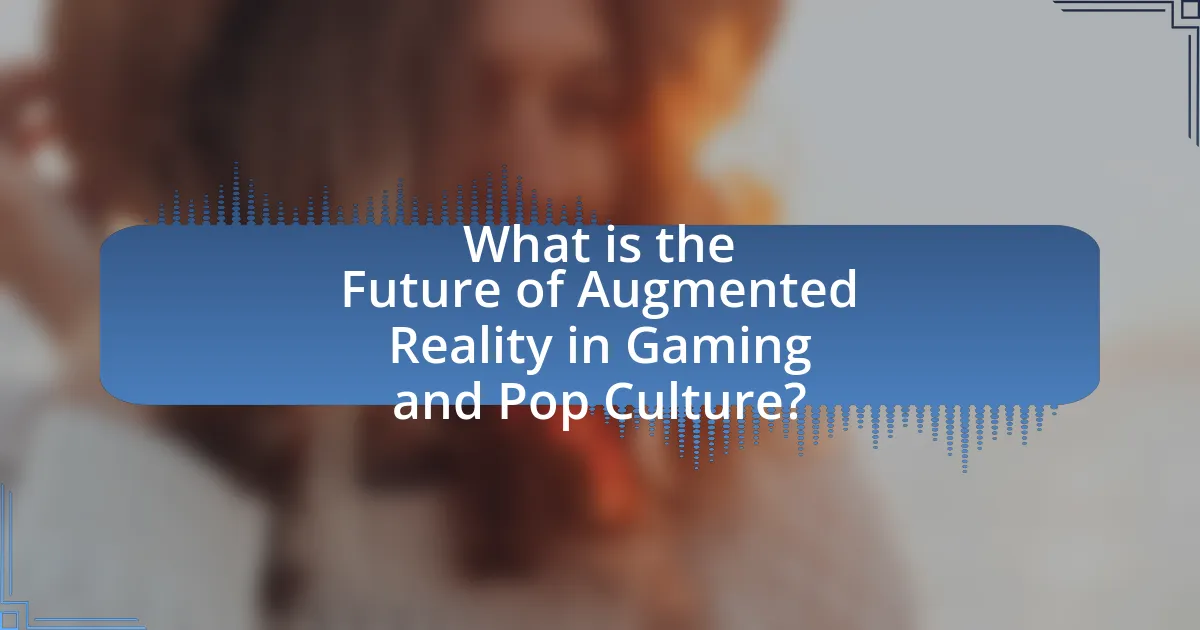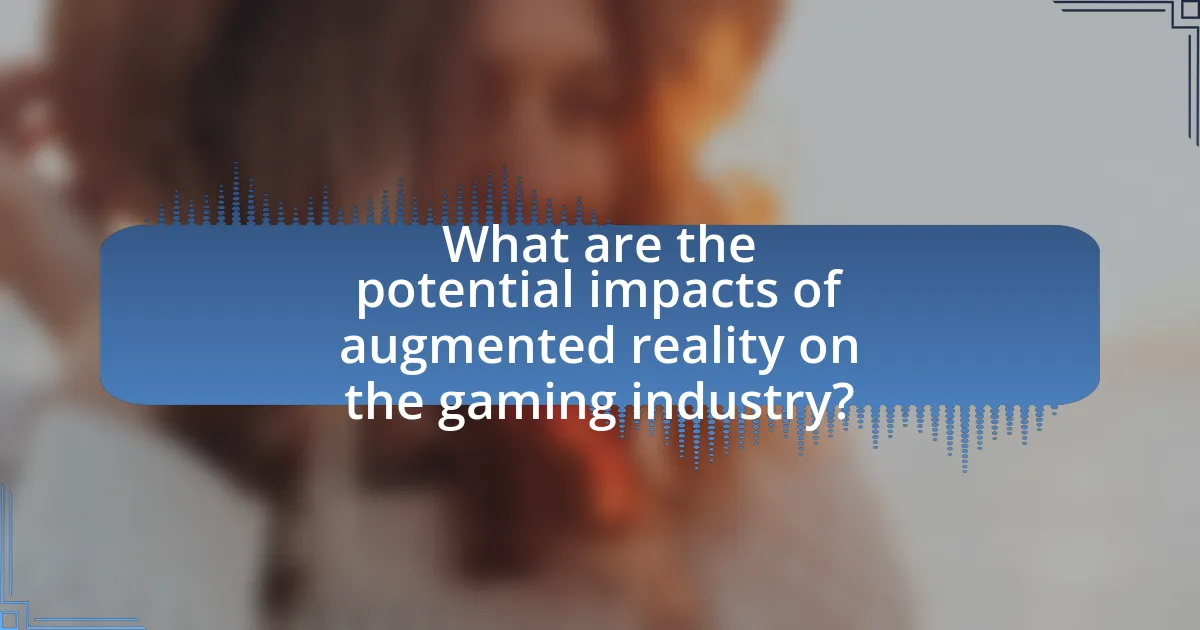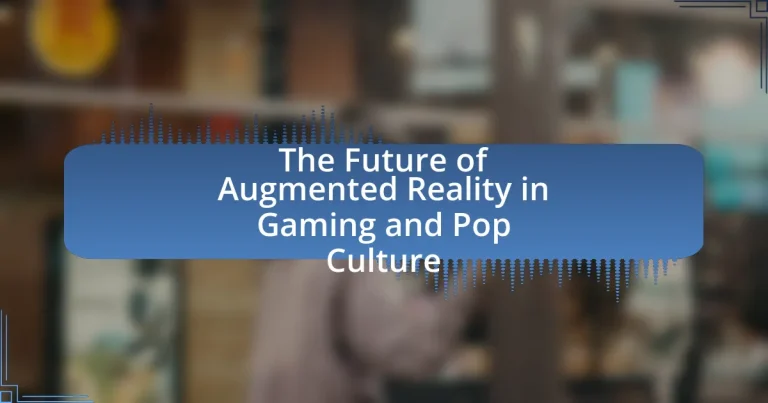The article focuses on the future of augmented reality (AR) in gaming and pop culture, highlighting its potential for significant growth driven by technological advancements and consumer adoption. It examines current applications of AR in gaming, such as Pokémon GO, and its integration into pop culture through social media and entertainment. Key trends shaping the future include enhanced social features, advancements in AR hardware, and location-based experiences. The article also addresses challenges such as privacy concerns and technical limitations, while exploring economic opportunities and innovative gameplay mechanics that AR can introduce to enhance user engagement and storytelling in both gaming and pop culture.

What is the Future of Augmented Reality in Gaming and Pop Culture?
The future of augmented reality (AR) in gaming and pop culture is poised for significant growth, driven by advancements in technology and increasing consumer adoption. AR is expected to enhance immersive experiences in gaming, allowing players to interact with virtual elements in real-world environments, as evidenced by the success of games like Pokémon GO, which generated over $1 billion in revenue within its first two years. Additionally, the integration of AR in pop culture is likely to expand through collaborations with entertainment franchises, as seen with AR applications in movies and music, creating interactive experiences that engage audiences in novel ways. The ongoing development of AR hardware, such as smart glasses and mobile devices, will further facilitate this evolution, making AR experiences more accessible and appealing to a broader audience.
How is augmented reality currently being used in gaming and pop culture?
Augmented reality (AR) is currently being used in gaming and pop culture primarily through interactive experiences that blend digital content with the real world. For instance, games like Pokémon GO utilize AR to allow players to capture virtual creatures in real-world locations, leading to increased physical activity and social interaction among players. Additionally, AR is featured in pop culture through applications like Snapchat filters, which overlay digital effects on users’ faces, enhancing social media engagement. The success of these applications is evidenced by Pokémon GO’s revenue exceeding $6 billion since its launch in 2016, demonstrating the significant impact of AR on both gaming and cultural trends.
What are the most popular augmented reality games today?
The most popular augmented reality games today include Pokémon GO, Ingress, and Harry Potter: Wizards Unite. Pokémon GO, launched in 2016, has maintained its popularity with over 400 million downloads and regular updates that introduce new features and Pokémon. Ingress, developed by Niantic, has a dedicated player base and has influenced the design of many AR games. Harry Potter: Wizards Unite, released in 2019, attracted fans of the franchise and utilized location-based gameplay similar to Pokémon GO. These games exemplify the successful integration of augmented reality into gaming, engaging players through immersive experiences that blend the digital and physical worlds.
How do augmented reality experiences enhance pop culture events?
Augmented reality experiences enhance pop culture events by creating immersive and interactive environments that engage audiences in novel ways. These experiences allow participants to interact with digital content overlaid on the real world, fostering deeper connections with the event’s themes and characters. For instance, during the Pokémon GO Fest, players engaged with augmented reality features that brought Pokémon into real-world locations, resulting in a reported attendance of over 20,000 participants and significant local economic impact. This integration of technology not only elevates the entertainment value but also encourages social interaction among fans, thereby enriching the overall experience of pop culture events.
What trends are shaping the future of augmented reality in these fields?
The future of augmented reality in gaming and pop culture is being shaped by trends such as increased integration of social features, advancements in hardware, and the rise of location-based experiences. Social features are enhancing multiplayer interactions, as seen in games like Pokémon GO, which encourages players to engage with each other in real-world locations. Advancements in hardware, including lighter and more powerful AR glasses, are making AR experiences more accessible and immersive, as demonstrated by devices like Microsoft HoloLens and Magic Leap. Additionally, location-based experiences are becoming more prevalent, allowing users to interact with digital content in specific physical environments, further blurring the lines between the virtual and real worlds. These trends indicate a significant shift towards more interactive and community-driven AR experiences in gaming and pop culture.
How is technology evolving to support augmented reality in gaming?
Technology is evolving to support augmented reality (AR) in gaming through advancements in hardware, software, and connectivity. Enhanced mobile devices, such as smartphones and tablets, now feature powerful processors and high-resolution displays, enabling more immersive AR experiences. For instance, Apple’s ARKit and Google’s ARCore provide developers with robust frameworks to create interactive AR applications, allowing for seamless integration of digital content with the real world. Additionally, the rollout of 5G technology facilitates faster data transmission, reducing latency and improving the responsiveness of AR applications. According to a report by Statista, the global AR gaming market is projected to reach $198 billion by 2025, highlighting the growing investment and interest in this technology.
What role do social media and streaming platforms play in augmented reality’s growth?
Social media and streaming platforms significantly accelerate the growth of augmented reality (AR) by providing widespread access and engagement opportunities. These platforms enable users to share AR experiences, fostering community interaction and driving user-generated content, which enhances visibility and adoption of AR technologies. For instance, Snapchat’s AR filters have attracted over 200 million daily active users, showcasing how social media can popularize AR features. Additionally, platforms like Twitch and YouTube facilitate live streaming of AR gaming, allowing creators to showcase AR applications in real-time, further promoting interest and investment in AR development. This synergy between social media, streaming, and AR creates a dynamic ecosystem that propels the technology’s growth in gaming and pop culture.
What challenges does augmented reality face in gaming and pop culture?
Augmented reality (AR) faces several challenges in gaming and pop culture, primarily including technological limitations, user adoption, and content creation. Technological limitations involve the need for advanced hardware and software to deliver seamless AR experiences, which can be costly and complex. User adoption is hindered by a lack of understanding and accessibility, as many potential users may not have the necessary devices or may find AR applications difficult to use. Additionally, content creation poses a challenge, as developing engaging and high-quality AR content requires significant investment and expertise. These challenges are supported by industry reports indicating that while AR has potential, widespread implementation is still in its early stages, with only a fraction of gamers actively using AR features in their experiences.
How do privacy concerns impact the adoption of augmented reality?
Privacy concerns significantly hinder the adoption of augmented reality (AR) technologies. Users often fear that AR applications may collect, misuse, or inadequately protect their personal data, leading to reluctance in embracing these technologies. For instance, a survey by the Pew Research Center found that 81% of Americans feel that the potential risks of data collection by technology companies outweigh the benefits. This apprehension can result in decreased user engagement and limit the market growth of AR applications in gaming and pop culture. Furthermore, incidents of data breaches and misuse of personal information have heightened awareness and skepticism among potential users, further complicating the widespread acceptance of AR technologies.
What are the technical limitations of current augmented reality technologies?
Current augmented reality technologies face several technical limitations, including issues with tracking accuracy, field of view, and hardware constraints. Tracking accuracy can be compromised in environments with poor lighting or complex backgrounds, leading to misalignment of virtual objects with the real world. The field of view is often limited, restricting the immersive experience, as many devices only provide a narrow visual range. Additionally, hardware constraints such as battery life, processing power, and weight of devices hinder prolonged use and performance, impacting user experience. These limitations are supported by studies indicating that effective AR applications require significant advancements in sensor technology and computational capabilities to enhance usability and realism.
How can augmented reality transform user engagement in gaming and pop culture?
Augmented reality can transform user engagement in gaming and pop culture by creating immersive experiences that blend digital content with the real world. This technology allows players to interact with virtual elements in their physical environment, enhancing gameplay and storytelling. For instance, games like Pokémon GO have demonstrated that AR can increase user participation and social interaction, with over 400 million downloads and a significant boost in outdoor activity among players. Additionally, AR can facilitate unique marketing strategies in pop culture, such as interactive advertisements and virtual events, which have been shown to increase brand engagement by up to 70%. These applications illustrate how augmented reality not only enriches user experiences but also drives community involvement and brand loyalty in gaming and pop culture.
What innovative gameplay mechanics can augmented reality introduce?
Augmented reality can introduce innovative gameplay mechanics such as location-based interactions, where players engage with virtual elements tied to real-world locations. This mechanic enhances immersion by allowing players to explore their environment while interacting with digital objects, as seen in games like Pokémon GO, which generated over $1 billion in revenue by leveraging real-world geography for gameplay. Additionally, augmented reality can facilitate social interactions through multiplayer experiences that blend physical and digital spaces, enabling players to collaborate or compete in real-time, thus fostering community engagement. These mechanics not only redefine player experiences but also expand the boundaries of traditional gaming by integrating physical and digital realms seamlessly.
How can augmented reality create immersive experiences for fans?
Augmented reality (AR) can create immersive experiences for fans by overlaying digital content onto the real world, enhancing engagement and interaction. For instance, AR applications allow fans to visualize 3D models of characters or objects from their favorite games or movies in their own environment, making the experience more personal and engaging. A notable example is Pokémon GO, which generated over $1 billion in revenue in its first year by encouraging players to explore their surroundings while capturing virtual creatures. This blend of physical and digital elements fosters a deeper connection between fans and the content, making experiences more memorable and interactive.

What are the potential impacts of augmented reality on the gaming industry?
Augmented reality (AR) significantly impacts the gaming industry by enhancing user engagement and creating immersive experiences. AR technology allows players to interact with digital elements in real-world environments, leading to more dynamic gameplay. For instance, games like Pokémon GO have demonstrated that AR can increase physical activity and social interaction among players, as evidenced by its over 400 million downloads and the way it encourages outdoor exploration. Additionally, AR can facilitate innovative game design, enabling developers to create unique narratives and gameplay mechanics that blend the virtual and physical worlds. This shift not only attracts a broader audience but also fosters new revenue streams through in-app purchases and location-based experiences.
How might augmented reality change game design and development?
Augmented reality (AR) will significantly transform game design and development by enabling immersive, interactive experiences that blend digital content with the real world. This integration allows developers to create games that utilize real-world environments as part of gameplay, enhancing player engagement and interaction. For instance, games like Pokémon GO have demonstrated how AR can encourage physical movement and social interaction, leading to increased player retention and community building. Furthermore, AR technology facilitates innovative storytelling techniques, allowing players to experience narratives in a more personalized and dynamic manner. The use of AR in game design is supported by advancements in hardware, such as AR glasses and mobile devices, which provide the necessary platforms for these experiences.
What new genres could emerge from augmented reality gaming?
New genres that could emerge from augmented reality gaming include location-based storytelling, social interaction games, and educational simulations. Location-based storytelling combines real-world exploration with narrative-driven gameplay, allowing players to engage with their environment while uncovering stories tied to specific locations. Social interaction games leverage augmented reality to enhance multiplayer experiences, fostering real-time collaboration and competition among players in shared physical spaces. Educational simulations utilize augmented reality to create immersive learning experiences, enabling users to interact with educational content in a hands-on manner. These genres reflect the potential of augmented reality to transform traditional gaming by integrating physical and digital experiences.
How can developers leverage augmented reality to enhance storytelling?
Developers can leverage augmented reality (AR) to enhance storytelling by creating immersive experiences that blend digital content with the real world. This integration allows users to interact with narrative elements in their physical environment, making stories more engaging and personalized. For instance, AR applications can overlay characters or scenes onto real-world locations, enabling users to experience the story as they move through different spaces. Research by the University of Southern California highlights that AR can increase emotional engagement by 30% compared to traditional storytelling methods, demonstrating its effectiveness in enhancing narrative experiences.
What economic opportunities does augmented reality present for the gaming industry?
Augmented reality presents significant economic opportunities for the gaming industry by enhancing user engagement and creating new revenue streams. The integration of augmented reality in gaming allows developers to create immersive experiences that attract a larger audience, as evidenced by the success of games like Pokémon GO, which generated over $1 billion in revenue within its first year. Additionally, augmented reality facilitates in-game purchases and advertising partnerships, providing developers with diverse monetization strategies. The global augmented reality gaming market is projected to reach $300 billion by 2025, highlighting the substantial financial potential for companies that invest in this technology.
How can augmented reality drive revenue through in-game purchases?
Augmented reality can drive revenue through in-game purchases by enhancing user engagement and creating immersive experiences that encourage spending. For instance, AR allows players to interact with virtual items in their real-world environment, making purchases feel more valuable and integrated into their gameplay. According to a report by Newzoo, the global gaming market is projected to reach $200 billion by 2023, with AR gaming contributing significantly to this growth. Games like Pokémon GO have demonstrated this potential, generating over $3 billion in revenue through in-game purchases by offering exclusive items and experiences that enhance gameplay. This model shows that augmented reality not only attracts players but also incentivizes them to invest in their gaming experience, thereby increasing overall revenue.
What partnerships can benefit from augmented reality in gaming?
Partnerships between technology companies, game developers, and hardware manufacturers can significantly benefit from augmented reality in gaming. For instance, collaborations between AR software developers like Niantic and gaming studios can enhance user engagement through location-based experiences, as seen in Pokémon GO, which generated over $3 billion in revenue since its launch in 2016. Additionally, partnerships with hardware manufacturers, such as Microsoft’s collaboration with game developers for the HoloLens, can create immersive gaming experiences that leverage advanced AR capabilities. These strategic alliances enable the integration of cutting-edge technology, driving innovation and expanding the market for augmented reality gaming.

How is augmented reality influencing pop culture beyond gaming?
Augmented reality (AR) is significantly influencing pop culture beyond gaming by enhancing experiences in various sectors such as fashion, art, and entertainment. For instance, brands like Gucci and Nike have utilized AR to create virtual try-on experiences, allowing consumers to visualize products in real-time, which has transformed shopping into an interactive experience. Additionally, art installations, such as those by artist Olafur Eliasson, incorporate AR to engage audiences in immersive ways, blending digital and physical realms. Furthermore, the rise of social media platforms like Snapchat and Instagram, which feature AR filters, has popularized this technology, enabling users to express themselves creatively and share content that resonates with broader cultural trends. These applications demonstrate how AR is reshaping consumer interactions and cultural expressions across multiple domains.
What are the applications of augmented reality in entertainment and media?
Augmented reality (AR) has diverse applications in entertainment and media, primarily enhancing user engagement and interactivity. In gaming, AR creates immersive experiences by overlaying digital elements onto the real world, as seen in popular games like Pokémon GO, which generated over $1 billion in revenue since its launch in 2016. In film and television, AR is used for interactive storytelling, allowing viewers to engage with content through mobile apps that provide additional layers of information or experiences related to the narrative. Furthermore, AR is utilized in live events and concerts, where it enhances performances with visual effects that interact with the audience in real-time, exemplified by the use of AR in concerts by artists like Travis Scott in Fortnite. These applications demonstrate how AR transforms traditional entertainment and media, making experiences more engaging and interactive.
How are movies and television integrating augmented reality experiences?
Movies and television are integrating augmented reality (AR) experiences by incorporating interactive elements that enhance viewer engagement. For instance, productions like “The Mandalorian” utilize AR technology to create immersive environments, allowing filmmakers to blend live-action with digital effects seamlessly. Additionally, platforms such as Snapchat and Instagram have collaborated with film studios to develop AR filters that promote movies, enabling users to interact with characters and scenes directly through their devices. This integration not only enriches storytelling but also provides audiences with a participatory experience, as seen in promotional campaigns for films like “Ready Player One,” which featured AR components to engage fans.
What role does augmented reality play in live events and concerts?
Augmented reality enhances live events and concerts by providing immersive experiences that engage audiences in innovative ways. This technology allows for interactive visuals, such as 3D animations and real-time effects, to be superimposed onto the physical environment, creating a unique blend of digital and physical elements. For instance, during the 2019 Coachella festival, artists like Billie Eilish utilized AR to create captivating visual displays that transformed the stage and audience interaction, demonstrating how AR can elevate the overall experience. Additionally, a study by the International Journal of Human-Computer Interaction found that AR applications in live events significantly increase audience engagement and satisfaction, highlighting its effectiveness in enhancing entertainment experiences.
How can augmented reality enhance marketing and advertising in pop culture?
Augmented reality (AR) can enhance marketing and advertising in pop culture by creating immersive experiences that engage consumers on a deeper level. This technology allows brands to integrate digital content with the real world, enabling interactive campaigns that capture attention and foster emotional connections. For instance, a study by Deloitte found that AR experiences can increase consumer engagement by up to 70%, leading to higher brand recall and purchase intent. Additionally, brands like IKEA and Pokémon Go have successfully utilized AR to create unique marketing strategies that resonate with audiences, demonstrating the effectiveness of AR in driving consumer interest and participation in pop culture.
What successful campaigns have utilized augmented reality effectively?
Successful campaigns that have effectively utilized augmented reality include the Pokémon GO launch by Niantic, which generated over $1 billion in revenue within the first ten months, and IKEA’s Place app, allowing users to visualize furniture in their homes, leading to a significant increase in customer engagement and sales. These campaigns demonstrate the power of augmented reality in enhancing user experience and driving business results.
How can brands create interactive experiences using augmented reality?
Brands can create interactive experiences using augmented reality by integrating AR technology into their marketing strategies, allowing consumers to engage with products in immersive ways. For instance, brands can develop AR applications that enable users to visualize products in their own environment, such as furniture retailers allowing customers to see how a couch would look in their living room. According to a study by Deloitte, 88% of consumers reported that AR experiences enhance their shopping experience, demonstrating the effectiveness of this approach. Additionally, brands can utilize AR for gamified experiences, where users complete challenges or interact with virtual elements to unlock rewards, further increasing engagement and brand loyalty.
What practical tips can creators use to implement augmented reality in their projects?
Creators can implement augmented reality (AR) in their projects by focusing on user experience, selecting the right tools, and ensuring seamless integration with existing platforms. Prioritizing user experience involves designing intuitive interfaces and interactions that enhance engagement, as studies show that user-friendly designs significantly increase user retention rates. Choosing the right tools, such as AR development platforms like Unity or ARKit, allows creators to leverage advanced features and streamline the development process. Additionally, integrating AR with popular social media platforms can expand reach and accessibility, as evidenced by the success of AR filters on Instagram and Snapchat, which have attracted millions of users and boosted content sharing.
What tools and platforms are best for developing augmented reality content?
The best tools and platforms for developing augmented reality content include Unity, ARKit, ARCore, and Vuforia. Unity is a widely used game development engine that supports AR through its robust features and cross-platform capabilities. ARKit, developed by Apple, allows developers to create AR experiences specifically for iOS devices, leveraging advanced features like motion tracking and environmental understanding. ARCore, Google’s counterpart to ARKit, provides similar functionalities for Android devices, enabling developers to build immersive AR applications. Vuforia is a versatile AR platform that supports various devices and offers features like image recognition and tracking, making it suitable for a range of AR projects. These tools are validated by their extensive use in successful AR applications and games, demonstrating their effectiveness in the industry.
How can creators ensure accessibility and user-friendliness in augmented reality experiences?
Creators can ensure accessibility and user-friendliness in augmented reality experiences by implementing inclusive design principles and conducting user testing with diverse groups. Inclusive design principles involve considering various user needs, such as visual, auditory, and mobility impairments, to create interfaces that are easy to navigate for everyone. For instance, providing text-to-speech options and adjustable text sizes can enhance usability for visually impaired users.
User testing with diverse groups allows creators to gather feedback on the effectiveness of their designs, ensuring that the experiences cater to a wide range of abilities and preferences. Research indicates that products designed with accessibility in mind not only benefit users with disabilities but also improve overall user satisfaction and engagement. According to a study by the World Health Organization, approximately 15% of the global population experiences some form of disability, highlighting the importance of accessibility in design.


